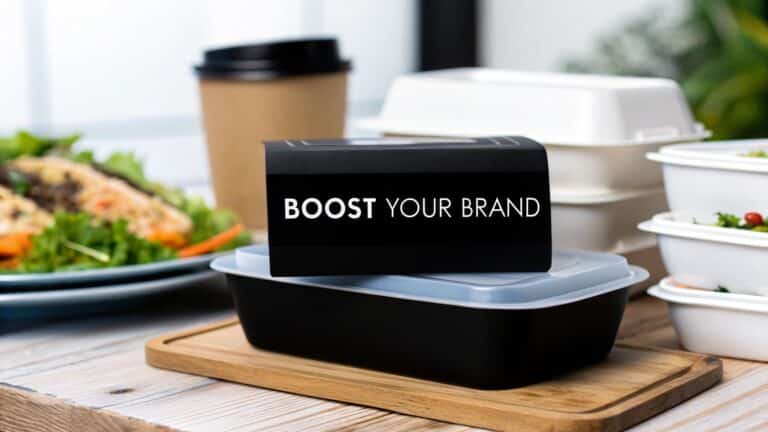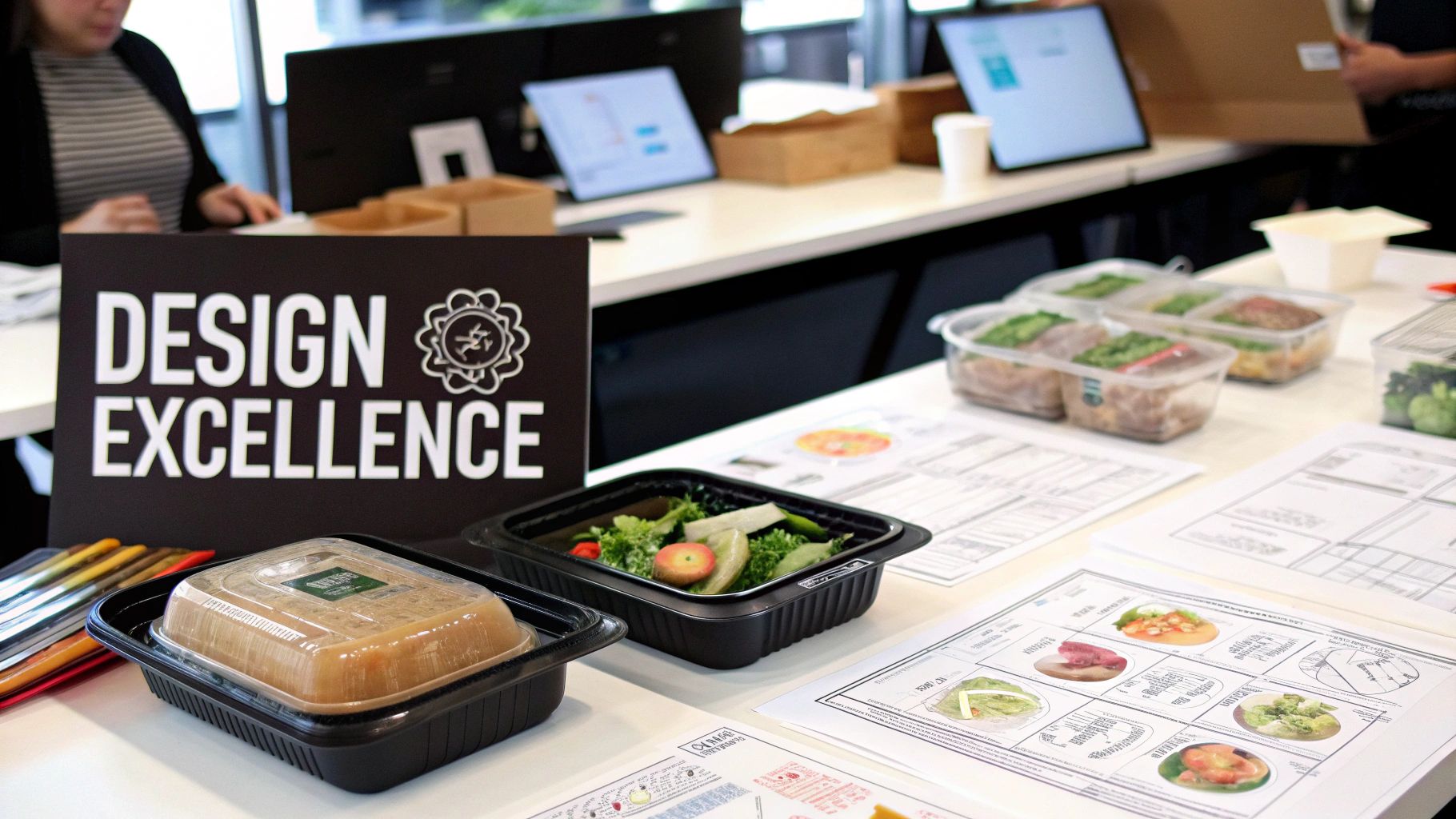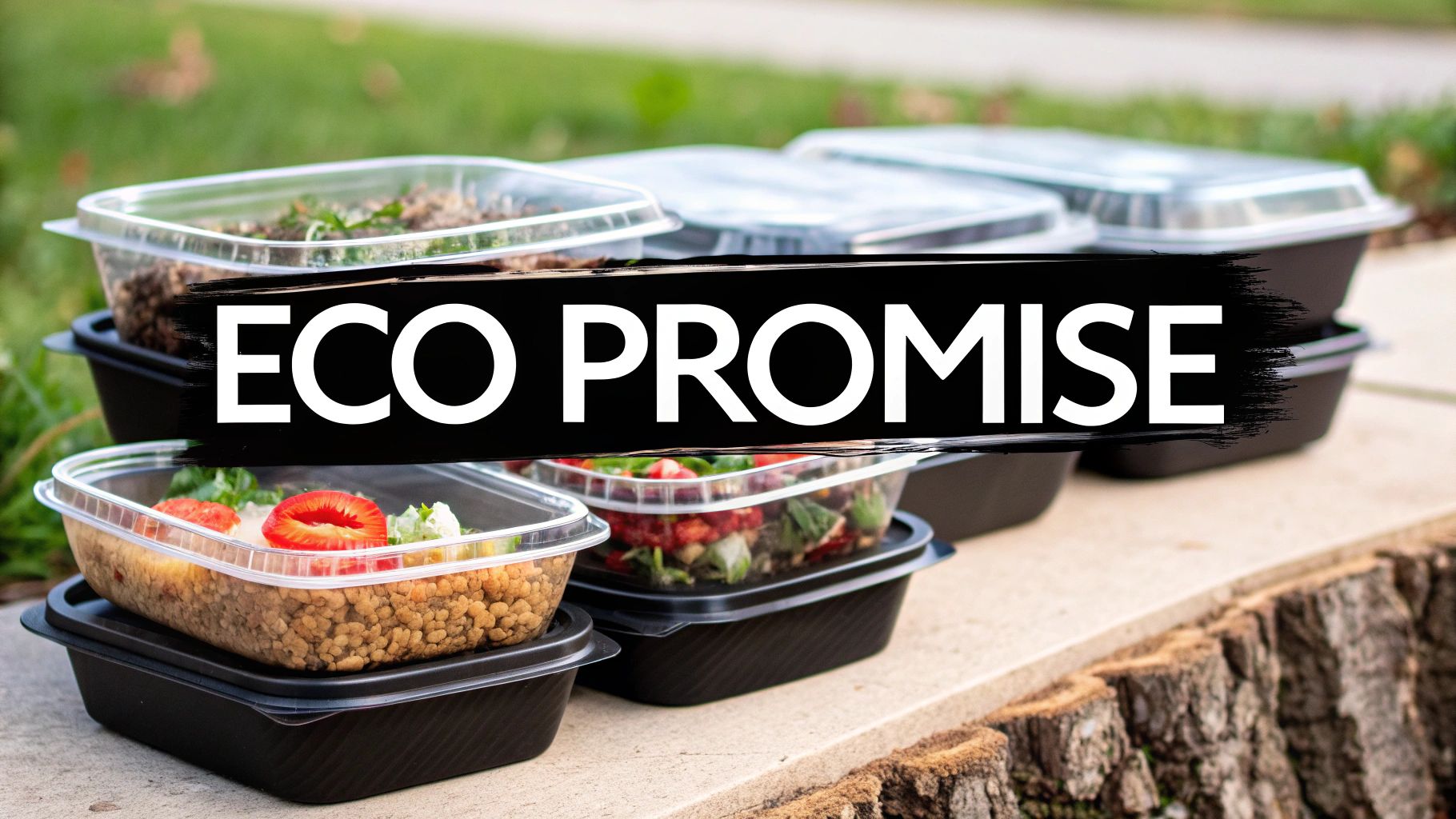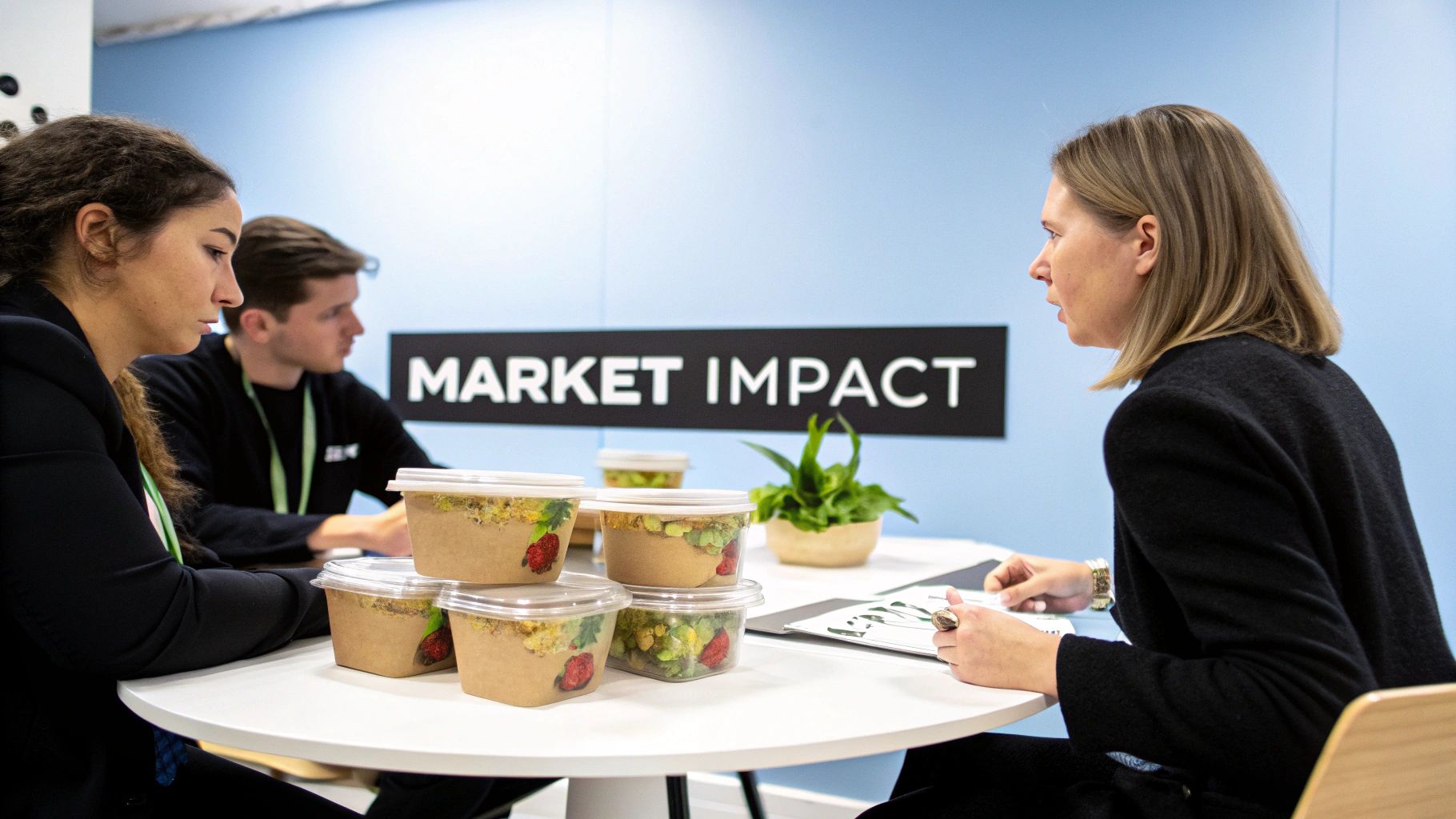The Strategic Power of Branded Food Containers
Branded food containers are much more than simple vessels. They are impactful marketing tools, offering a unique way to extend your brand’s presence beyond your physical location. They create a lasting impression since each container acts like a miniature billboard, subtly promoting your brand wherever it goes.
This low-key yet effective marketing approach strengthens brand recognition and cultivates customer loyalty.
Turning Takeout into Touchpoints
The growing popularity of takeout has elevated the humble food container to a vital brand touchpoint. A visually appealing container enhances the customer experience, making their meal feel special. This positive feeling then transfers to your brand, boosting the chances of repeat business.
Branded containers also frequently find a second life in homes and offices, extending your brand’s visibility even further.
Success Stories in Branding
Many businesses have seen significant increases in customer recognition by focusing on thoughtful container design. Some companies even use their branded containers to create shareable moments on platforms like Instagram, encouraging customers to post photos of their meals.
This type of organic social media marketing can greatly expand your brand’s reach. The strategic advantage of branded containers isn’t just for large companies; businesses of all sizes can reap the benefits.
The global food storage container market is booming. It reached USD 160 billion in 2024 and is expected to exceed USD 247.29 billion by 2034. This expansion is driven by the increasing demand for convenient and sustainable food storage solutions.
The following table illustrates the projected growth in more detail:
Global Food Container Market Growth
| Region | Market Size (Billions USD) | Growth Rate | Key Growth Drivers |
|---|---|---|---|
| North America | 70 | 5.2% | Increased consumer spending on sustainable packaging, growth in online food delivery services |
| Europe | 55 | 4.8% | Stringent regulations regarding food safety and packaging waste, rising demand for reusable and eco-friendly containers |
| Asia Pacific | 25 | 7.1% | Rapid urbanization and changing lifestyles, growing awareness of food hygiene and safety, and expansion of the organized retail sector |
| Rest of the World | 10 | 6.5% | Increasing disposable incomes, rising demand for convenient food packaging solutions |
Maximizing Brand Extension
Branded food containers offer a frequently overlooked chance for brand extension. By featuring your logo, colors, and messaging on your containers, they become physical embodiments of your brand identity.
This reinforces your brand message with every customer interaction, crafting a unified experience. Ultimately, branded food containers strengthen the link between your product and your customer, nurturing brand loyalty and driving business growth.
Crafting Memorable Brand Experiences Through Packaging
Branded food containers are much more than simple vessels. They are powerful tools that shape customer perception and build brand loyalty. They elevate the entire dining experience, transforming an ordinary meal into a memorable interaction with your brand. This effect is amplified by the often-overlooked psychology of packaging, which subtly influences how customers view your brand and its offerings.
The Psychology of Packaging
Color, logo placement, and even the shape of the container play key roles in brand recall and forging an emotional connection with the consumer. Warm colors like red and yellow, for example, are known to stimulate appetite, while green is frequently associated with freshness and healthy choices. A strategically placed logo ensures your brand remains visible, and a unique container shape can differentiate your product from the competition.
Well-designed packaging can also create those coveted “Instagram-worthy” moments. This encourages customers to share their dining experiences online, turning your branded containers into effective, viral marketing assets. This type of organic promotion can significantly expand your brand’s reach and build a loyal community around your product.
Aligning Aesthetics With Brand Narrative
The most effective branded food containers seamlessly blend aesthetics and functionality. The design should reflect your overall brand narrative, communicating your core values and unique personality. Practicality, however, remains paramount. Containers must maintain the food’s temperature, preserve freshness, and offer appropriate portioning.
Both form and function contribute to a positive customer experience. A visually appealing container that leaks or fails to keep food warm will ultimately detract from the brand image. The key to successful packaging lies in the careful balance between visual appeal and practical utility to help boost your brand.
The Growing Market for Branded Food Containers
Current market trends clearly demonstrate the rising demand for branded food containers. The global market for food containers reached an estimated value of USD 331.7 billion in 2024. It’s projected to grow at a CAGR of 4.5% between 2025 and 2030. Factors driving this growth include the increased demand for packaged and processed foods, the shift towards convenient meal options, and rising disposable incomes. More detailed statistics can be found here. The North American market, particularly in the U.S., dominates this industry, driven by high consumption of packaged foods and ongoing development of sustainable packaging.
Ultimately, crafting memorable brand experiences through packaging requires a deep understanding of consumer psychology, thoughtful design, and a commitment to both aesthetics and practical functionality. By incorporating these elements, businesses can transform ordinary food containers into powerful marketing tools that enhance customer loyalty and drive significant growth.
Sustainable Branded Food Containers: Beyond the Eco-Buzzword
Sustainability is no longer a niche market trend; it’s a core business value. This is especially relevant for food packaging, where consumers are increasingly aware of the environmental impact of their choices. This means businesses need to prioritize sustainable branded food containers. This not only benefits the environment but also builds a positive brand image and encourages customer loyalty.
Navigating the Landscape of Sustainable Materials
Choosing the right materials is the first step toward sustainable packaging. This involves going beyond simple marketing claims and truly understanding the environmental impact of each option. Bioplastics, often marketed as eco-friendly, can be deceptive. While some bioplastics are compostable in home composting systems, others require specialized industrial composting facilities, which aren’t always readily accessible. This can, unfortunately, result in these materials ending up in landfills, negating their intended environmental benefits.
Bamboo and bagasse (sugarcane fiber) present compelling sustainable alternatives. These are rapidly renewable resources and often compostable in the correct environment. However, careful consideration must be given to their sourcing and processing to ensure genuine sustainability. Transportation distances and manufacturing processes, for instance, can significantly affect the overall environmental footprint. This complexity highlights the need for transparency and thorough research when selecting sustainable materials.
To help illustrate the differences between various sustainable options, let’s look at the following comparison:
Comparison of Sustainable Food Container Materials
| Material Type | Environmental Impact | Cost Range | Durability | Branding Effectiveness |
|---|---|---|---|---|
| Bioplastics (PLA) | Compostable in industrial facilities, but can end up in landfills if not properly disposed of. | Moderate to High | Varies depending on the specific type of bioplastic | It can be molded into various shapes and easily printed on. |
| Bagasse (Sugarcane Fiber) | Compostable, rapidly renewable resource. Transportation and processing can impact the overall footprint. | Low to Moderate | Good for dry foods, but can be less durable with liquids. | Natural appearance can be appealing, but printing options may be limited. |
| Bamboo | Highly renewable, durable, and biodegradable. Transportation can be a factor. | Moderate to High | Very durable and reusable. | Natural look can be attractive, laser engraving offers branding opportunities. |
Balancing Cost and Customer Loyalty
Cost remains a significant challenge when adopting sustainable branded food containers. They are often more expensive than conventional options. This can be a considerable barrier, particularly for small businesses. However, many companies are discovering that this initial investment yields long-term benefits. Consumers are increasingly willing to support businesses committed to environmental responsibility. They often show increased brand loyalty and are prepared to pay more for sustainable packaging.
This change in consumer behavior emphasizes the importance of aligning your brand with customer values. And to do this effectively, you need to communicate properly and maintain the same brand voice and consistency across different platforms. Communicating your environmental efforts effectively through your packaging choices can also be a strong differentiator.
Communicating Your Commitment
Transparency is essential for building consumer trust regarding sustainability. Communicating the environmental benefits of your packaging is critical. This might involve clear labeling on the containers or detailed information on your website and marketing materials.
Including certifications from reputable organizations can further enhance credibility. This strengthens consumer confidence and reinforces your commitment to environmental stewardship. The food packaging industry, encompassing branded food containers, is experiencing significant growth. The global market is projected to reach USD 512 billion by 2028. Key growth drivers include customization and branding, health and safety considerations, and material science innovations, like alternatives to single-use plastics and smart packaging. The food containers market is expected to reach USD 489.3 billion by 2029, growing at a CAGR of 10.7%. This expansion underscores the growing importance of branded food containers in meeting consumer demands for safety, sustainability, and convenience. This growth presents both opportunities and challenges for businesses aiming to become leaders in sustainable packaging.
Creating Distinctive Branded Food Containers That Stand Out
Generic food containers are a missed opportunity. Instead of blending in, your packaging should enhance your brand and attract customers. Creating distinctive, branded food containers doesn’t require a huge budget, just smart planning and an understanding of design principles. This section explores cost-effective customization techniques that will make your food packaging truly stand out.
The Power of Color Psychology
Color is the first thing a customer notices, making it a powerful tool for influencing their perception of your product. Warm colors like red and orange are known to stimulate appetite, while green often suggests freshness. Consider your brand’s personality when selecting colors. An upscale restaurant might choose elegant black and gold, while a lively juice bar could use bright, tropical shades. The right color palette reinforces your brand message and creates a memorable experience.
Typography and Brand Messaging
Typography is more than just choosing a font; it’s about conveying your brand’s voice. A sleek, minimalist font might work well for a health-focused brand, while a traditional serif font could complement a classic bakery. Short, impactful messages on your containers can also strengthen your brand identity. Consider adding a tagline, a core value, or a simple “Thank You” to make a lasting impression.
Finishing Touches That Enhance Perceived Value
Small details can significantly impact how customers perceive the value of your food. A matte finish suggests elegance, while a glossy finish conveys energy and fun. Consider techniques like embossing or debossing your logo to add a tactile element that elevates the experience. These subtle additions can make a big difference, creating a more premium feel and strengthening the customer’s positive association with your brand.
Balancing Design Ambition With Production Realities
While creativity is key, practicalities matter too. Minimum Order Quantities (MOQs) can impact design choices, and understanding lead times is essential for timely delivery. Quality control is paramount, as your containers are a direct reflection of your brand. Partnering with a reliable manufacturer who understands your vision and maintains high-quality standards is crucial.
Working Effectively With Manufacturers
A strong relationship with your manufacturer is vital. Open communication is key; provide clear specifications and ensure they understand your brand guidelines. Requesting samples early in the process allows you to verify quality and design accuracy. Consistent communication throughout production will help prevent delays and ensure the final product aligns with your expectations. This proactive approach will yield high-quality, branded food containers that accurately represent your brand and elevate the customer experience.
How Thoughtful Containers Transform Customer Experience
Branded food containers are no longer just about transporting food. They’re now a crucial part of shaping the customer experience and influencing how people perceive your brand. Every interaction a customer has with your packaging, from picking up their order to the final bite, contributes to their overall impression.
The Impact of Design on Perception
Imagine a flimsy container leaking sauce. It instantly dampens a customer’s enthusiasm for their meal. On the other hand, a sturdy, well-designed container can elevate the perceived value of the food. Customers subconsciously link the quality of the packaging with the quality of the food inside. A premium container suggests attention to detail, implying the same care went into preparing the food. This positive association significantly impacts customer satisfaction and can even boost reorders.
For example, picture a gourmet salad in a plain container. While it might taste delicious, the presentation is underwhelming. Now, envision that same salad in a sleek, branded container with a custom design. The experience is instantly elevated. The salad feels more special and worth a higher price. This demonstrates how packaging influences perception and builds a sense of value.
Enhancing the Dining Experience
Branded containers are designed with the entire customer journey in mind. Practical aspects like temperature maintenance and portioning are crucial. A hot meal arriving cold, or a large portion spilling from a small container, can ruin the dining experience. This highlights the importance of functionality in design.
- Temperature control: Insulated containers keep hot foods hot and cold foods cold, ensuring meals arrive at the perfect temperature.
- Portion satisfaction: Correctly sized containers enhance perceived value and minimize food waste.
- Ease of use: Features like resealable lids and microwave-safe materials add convenience.
These details contribute significantly to customer satisfaction. Thoughtful container design creates a more positive and enjoyable experience.
Building Brand Loyalty Through Packaging
Beyond the immediate meal, branded containers build brand loyalty. Visually appealing and functional packaging leaves a lasting positive impression, strengthening the customer’s connection with your brand and encouraging repeat business. High-quality containers can even spark conversations, leading to valuable word-of-mouth recommendations.
Moreover, branded containers extend your brand’s reach. Reusable containers might find a second life in customers’ homes, acting as a constant reminder of your brand. This ongoing exposure strengthens brand recognition and reinforces loyalty.
By focusing on container design, businesses enhance customer experience, build stronger brand connections, and drive growth. The right packaging can transform a simple meal into a memorable brand experience, reinforcing loyalty and encouraging positive word-of-mouth marketing. Investing in high-quality, branded food containers is a strategic decision that significantly impacts a business’s bottom line. It shows the power of thoughtful design and its ability to transform the customer journey.
Measuring Return: The Business Case for Premium Containers
Branded food containers are more than just an expense; they’re a strategic investment in your brand. Like any investment, understanding the potential return is critical. This section offers a framework for measuring the ROI of premium containers, going beyond simple branding to showcase tangible financial advantages.
Key Metrics for Evaluating Packaging Performance
Savvy restaurant owners and delivery services recognize the importance of specific metrics to evaluate packaging effectiveness. These extend beyond basic cost considerations, focusing on the wider impact on customer behavior and brand perception. For example, container-specific conversion rates reveal how branded packaging influences purchasing decisions. Monitoring these rates can highlight the success of different container designs and messaging.
Customer retention is another key indicator of long-term success. Premium containers can significantly improve retention rates by elevating the customer experience. Assessing this impact involves analyzing customer data and finding connections between packaging choices and repeat business.
Finally, the influence of social media shouldn’t be overlooked. Branded containers, especially visually appealing ones that encourage sharing, can generate significant social media visibility. Tracking mentions, shares, and engagement related to your packaging provides valuable insights into its marketing performance.
A/B Testing: Refining Your Container Strategy
A/B testing allows for direct comparison of different packaging choices to identify the top performer. By introducing variations to a small customer segment, testing can occur without operational disruption. For instance, test two container designs with separate customer groups, then measure conversion rates and gather feedback.
A/B testing provides data-driven insights into how different packaging elements—color, material, or messaging—influence customer behavior. This allows for refinement of your container strategy and optimization for maximum impact.
Calculating Lifetime Value Increase
The real value of premium packaging extends beyond the initial sale. By building customer loyalty, these containers can increase the lifetime value of each customer. This translates to customers returning more often, ordering more frequently, and recommending your business.
Calculating this lifetime value increase involves examining customer spending habits and correlating them with the use of branded packaging. This long-term perspective reveals the significant financial upside of investing in high-quality containers.
Breakeven Analysis for Food Service Businesses
Understanding your breakeven point is crucial for strategic packaging decisions. This calculation pinpoints where the revenue generated from using branded containers equals their increased cost.
A simple breakeven analysis template helps determine the necessary increase in orders or customer lifetime value to offset the higher cost of premium packaging. This provides clear financial justification for investing in branded containers.
For a wide selection of high-quality, branded food containers, check out MrTakeOutBags.com. We offer various options to elevate your brand and enhance the customer experience.







Comments are closed.